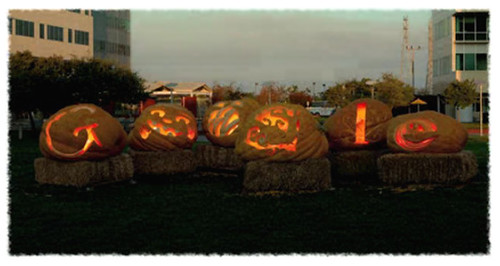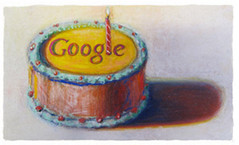Google’s special logos (“Doodles“) commemorating holidays and historical events have been successful at conveying a playful nature for the ever-growing corporation. As time has gone by, the special logo treatments have begun veering off from playful quirkiness and have perhaps actually crossed the line of legibility. The Father’s Day Google logo deployed today is perhaps the worst example of all:

The neckties, intended to whimsically reference the letters spelling out “Google”, have become so abstracted that I think their resemblance to the letters in the name have utterly disappeared.
Graphic artists can certainly recognize and appreciate the rough symbolic shaping, but this sort of symbolic reference is really too vague for most of the public.
I’ve enjoyed watching Google play with their logo for years while dancing all over traditional corporate intellectual property law for how trademarks should be treated. I’ve long felt that Google was thumbing their nose at frustratingly conservative IP lawyers who anally force major corporate employees to follow logo use style guides mindlessly. After all, the name itself can be a trademark, regardless of graphic treatment, and trademark law certainly is flexible enough to allow some degree of logo variations. Google’s logo treatments have shown that temporary logo variations and nonstandard logo treatments can be effected without incurring risk of “losing control of the mark”.
The problem I see with today’s Father’s Day logo is that the humorous treatment has become way too subtle for its own good — the logo is illegible, and devoid of the website most reasonable individuals would be unable to see the company’s name in the treatment.
Have Google logos finally jumped the shark with this treatment? Has the joke worn thin?
The challenge for the Google logo artists has been continuing the thematic treatments without becoming a cliche. Recently, Google has experimented with enabling individuals to display custom background images on the homepage, and their “doodle” advertising the capability was so roundly criticized that they removed the feature. The background image treatment was so derivative of Bing’s changing homepage background images (which aped Ask.com’s earlier treatment) that many thought Google was trying to immitate the feature.
I think the takeway from this is that Google should stick with what is working for them and avoid straying too far from successful formulas. Today’s doodle logo lost the “Googleness” that made the concept so charming to begin with.
I expect they’ll continue displaying special logos, but they need to make them resemble the standard logo more closely or else the charm will be lost permanently.







Google’s Dracula Logo
Thursday, November 8th, 2012I can’t resist mentioning Google’s Dracula themed logo today celebrating the 165th birthday of Bram Stoker!
Sponsored search results associated with Google's Bram Stoker logo. (Click to enlarge.)
The logo presents scenes from Stoker’s Dracula uber-famous vampire book, done up in a woodcut-illustration style very reminiscent of the illustrations of Aubrey Beardsley, from the same time period. Dracula was published in 1897.
What may be more significant for search marketers, however, is the special search results page the logo is linked-to, which features Bram Stoker-related books, the Sponsored “shop for” sidebar box and the Wikipedia entry highlights box, along with the usual Universal Search items peppered through the search results listings: news search, author-tagged posts, video and image search results.
This logo and associated search results treatment seems to be specifically designed to help propel featured sponsor ad clicks, as well as to promote Google’s robust search results features.
It calls to question — will Google continue to specifically try to monetize their future Google Doodle logos in a similar fashion?
Tags: advertising, Bram Stoker, Dracula, Google Doodles, Google Logos, search monetization, sponsored ads, vampires
Posted in Advertising, Art, General Commentary, Google, Images | Comments Off on Google’s Dracula Logo